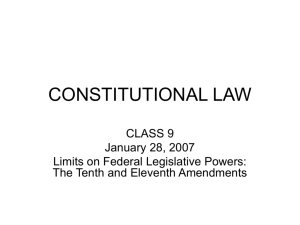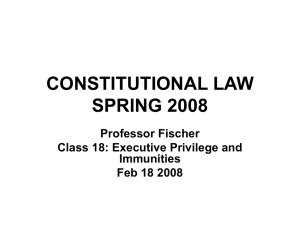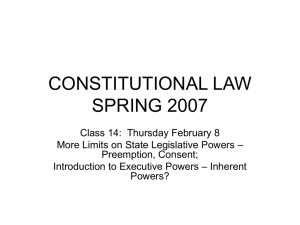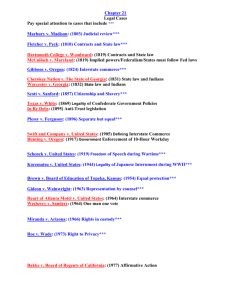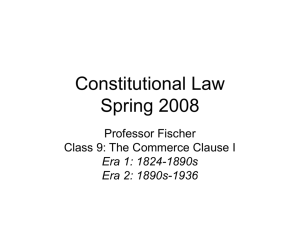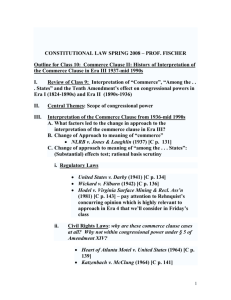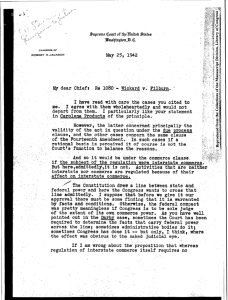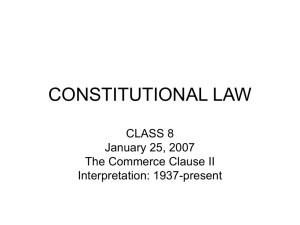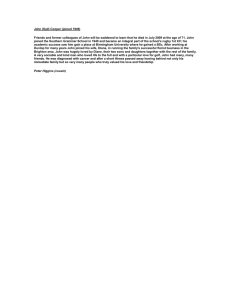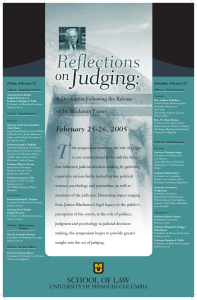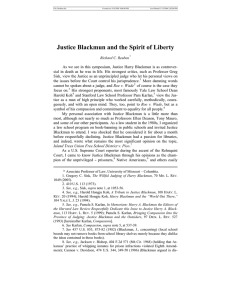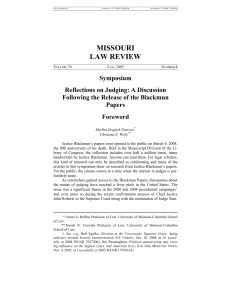Slides for Class 12
advertisement
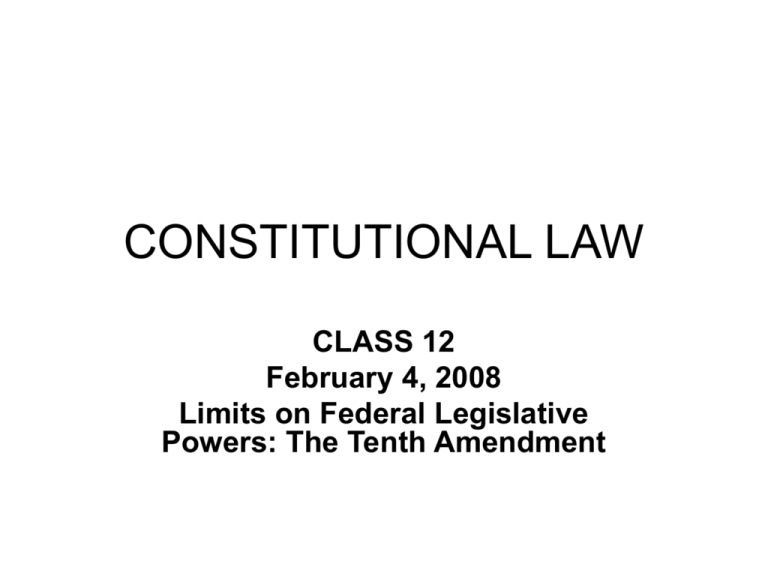
CONSTITUTIONAL LAW CLASS 12 February 4, 2008 Limits on Federal Legislative Powers: The Tenth Amendment MODERN LAW: 3 THINGS CAN BE REGULATED UNDER THE COMMERCE POWER • 1. Channels of interstate commerce (e.g. roads, terms/conditions on which goods can be sold interstate) • 2. Instrumentalities of interstate commerce (e.g airlines, railroads, trucking) and persons/things in intersatet commerce • 3. any economic activity that has a substantial relationship with interstate commerce or substantially affects interstate commerce (read together with N & P clause) The Tenth Amendment • The powers not delegated to the United States by the Constitution, nor prohibited to it by the States, are reserved to the States respectively, or to the people. ERA I: 1824-1890s Gibbons v. Ogden (1824) [C p. 113] ERA II: 1890s-1836 Hammer v. Dagenhart (1918) [C p. 125] Hammer v. Dagenhart (1918) (CB • Justice Day wrote the majority opinion • Powerful dissent by Justice Holmes (pictured left) (joined by McKenna, Brandeis, and Clarke Zone of Activities • In Era 2, Court accepts that a zone of activities is reserved to states by Tenth Amendment and this limits commerce power (dual sovereignty) • This zone is not consistently defined? ERA 3: 1937-1990s U.S. v. Darby (1941) [C p. 134] • Justice Stone delivered opinion of the Court (unanimous) • Tenth Amendment “states but a truism that all is retained which has not been surrendered.” Era 3: National League of Cities v. Usery (1976) [C p. 145] • 5-4 Majority opinion written by Justice Rehnquist (joined by Burger, Stewart, Blackmun, and Powell) • Concurring opinion by Blackmun • Dissent by Brennan joined by White and Marshall Era 3: Garcia v. San Antonio Metropolitan Transit Authority (1985) [C p.148] • 5-4 overrules Usery • Justice Blackmun wrote the majority opinion, joined by Brennan, White, Marshall, and Stevens • Powell, Rehnquist, O’Connor, Burger dissent Beginning of Tenth Amendment Era IV (Revival as a limit): Gregory v. Ashcroft (1991) [C p. 176-177] • Sandra Day O’Connor wrote for the Court (joined by Rehnquist, Scalia, Souter, Kennedy, and as for the judgment, White and Stevens) • Blackmun, joined by Marshall, dissented • Statutory construction case • “Clear statement” rule New York v. United States (1992) [C p. 177] • Justice O’Connor delivered the opinion of the Court (joined by Rehnquist, Kennedy, Souter, Thomas, Scalia) • 6-3 decision • Dissenters: White, Blackmun, Stevens New York v. United States (1992) [C p. 177] • Dissent of Justice White (joined by Blackmun and Stevens) • For which professional football team(s) did “Whizzer” White play? Only 3 Current US Low Level Nuclear Waste Disposal Sites Printz v. United States (1997) [C p. 186] • 5-4 decision • Scalia wrote majority opinion (joined by Rehnquist, O’Connor, Kennedy, Thomas) • Dissenters: Stevens, Souter, Ginsburg, Breyer Printz v. United States (1997) [C p. 186] • Concurring opinion of Thomas – he questions whether the Second Amendment confers an individual right • Supreme Court will consider that issue in a challenge to DC handgun regulation, District of Columbia v. Heller – oral argument to be on 3/18/2008 Reno v. Condon (2000) [C p. 195] • Chief Justice Rehnquist wrote the opinion of the Court • Unanimous decision • How is this case different, if at all, from Printz and New York? Reno v. Condon (2000) [C p. 195] • DPPA Act enacted after actress Rebecca Schaeffer (star of 1980s sitcom: My Sister Sam) was killed by a crazed fan who had obtained her home address from the CA DMV via an AZ private investigator)
